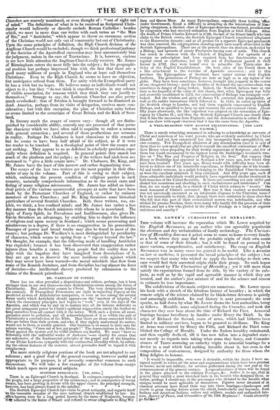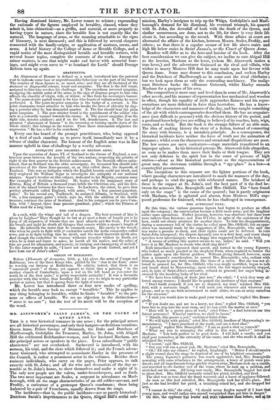MR. LOWER'S CURIOSITIES OF HERALDRY.
Thus volume will increase the reputation which Mr. Lower acquired by his English Surnames, as an author who can agreeably popularizt the abstruse and dry technicalities of family arohteology. The Curiosi- ties of Heraldry does not a priori seem to come so home to every family as a book where they may find the probable origin of their own name or that of some of their friends ; but it will be found on perusal to be more various, comprehensive, and satisfactory. The essay on English Surnames was in many cases too general to be useful. Like a treatise on law or medicine, it presented the broad principles of the subject ; but we suspect that many who wished to apply the knowledge to their own case would find their ancestral origin elude their grasp. No such hopes will be raised by The Curiosities of Heraldry ; yet it will more than satisfy the expectations formed from its title, by the variety of its sub- jects, as well as by the rapid and agreeable manner in which they are treated, and the author's just mixture of zeal for the science and reason to estimate its true importance.
The subdivisions of the main subject are numerous. Mr. Lower opens his book with a sketch of the fabulous history of heraldry ; in which the remote origin of the science claimed by its black-letter devotees is quietly and amusingly exhibited. Its real history is next presented ; the true epochs, as laid down by what Mr. Lower deems the best authorities, being as follows. Heraldic arms originated during the Crusades, and took the character they now bear about the time of Richard the First. Armorial bearings became hereditary in families under Henry the Third. In the reign of Richard the Second, coats of arms, which had hitherto been limited to military services, began to be granted to civilians: The King at Arms was created by Henry the Fifth, and Richard the Third este, blished the College of Heralds. Under the Tudors heraldry culminated, and then rapidly declined, till it has now fallen into a degraded state ; not merely as regards men taking what arms they fancy,-and Commis- sioners of Taxes assessing an unlucky Wight to armorial bearings for a device to a seal which had nothing heraldic about it, but even in the composition of coat-armour, designed by authority for those whom the King delights to honour.
" It would be impossible, even were it desirable, within the limits I have as- signed myself, to notice all the arms and augmentations which have been granted to heroes, naval and military, for services performed during the last and at the commencement of the present century. A superabundance of them will be found in the plates attached to the ordinary Peerages, &c. Suffice it to say, that in 'general they exhibit a most wretched taste in the heralds who designed them, or rather, perhaps I should say, in the personages who dictated to the heralds what ensigns would be most agreeable to themselves. Figures never dreamed of ih classical armoury havefound their way into these ..rings,---landscapes and words in great staring letters across the shield, bomb-shells and bayonets, East Indians and American Indians, sailors and soldiers medals and outlandish ban- ners, figures of Peace, and Grenadiers Of the 79th Yi'egiment ! Could absurdity go further?" Having dismissed history, Mr. Lower comes to science ; expounding the rationale of the figures employed in heraldry, classed, where they admit it, into chimerical—as a griffin, and natural, or more properly as having types in nature, since the heraldic lion is not exactly like the natural. The language of arms, or the meaning attachable to the signs of blazonry, is next discussed; and this is followed by several chapters • connected with the family-origin, or application of mottoes, crests, and Arms. A brief history of the College of Arras or Heralds College, and a rapid notice of the most distinguished heralds and heraldic writers, with several lesser topics, complete the contents of the work. Among the minor matters, is one that might make sad havoc with armorial bear- ings, and might even serve to " to bombard the Lords" should Peerage Reform turn up again.
ABATEMENTS.
An Abatement of Honour is defined as a mark introduced into the paternal coat to indicate some base or ungentlemanlike behaviour on the part of the bearer. The number of these figures is, as usual, nine; and they are all tinctured of the stainant or disgraceful colours, tenn4 and sanguine. The first is the delf terms, assigned to him who revokes his challenge. 2. The eseocheon reversed sanguine, occupying the middle point of the arms, is the sign of disgrace proper to him who ()ands the chastity of virgin, wife, or widow, or flies from his sovereign's banner. S. The point-dexter parted tame is for him who boasts of valiant actions he never performed. 4. The point-in-point sanguine is the badge of a coward. 5. The point champaine tens attaches to him who breaks the laws of chivalry by slay- mg a prisoner after he has demanded quarter. 6. The liar should bear the plain point sanguine. 7. The gore sinister tens is the punishment of the soldier who acts in a cowardly manner towards his enemy. 8. The gusset sanguine, if on the right side, denotes adultery; and if on the left, drunkenness. 9. The last and greatest " abatement of honour " is the reversing or turning upside down of the whole shield: this belongs to the traitor. From these abatements originates the expression " He has a blot in his scutcheon."
Every one has heard of the prompt practitioner, who, being opposed by a deed of such standing as to prove itself, immediately met it by a release of similar character. The honour of the English arms was in like manner upheld in time of challenge by a worthy advocate.
ANTIQUITY AND DEGREES OF BRITISH ARMS.
'Upon the accession of James VI. of Scotland to the throne of °land, a con- troversy arose between the heralds of the two nations, respecting e priority. of right to the first quarter in the British achievement. The Scottish officers main- tamed, that as Scotland was the older sovereignty, its treasured lion should take precedence of the three lions-passant, or as they called them, the leopards, of England. This was an indigmty which the English heralds could not brook, and they employed Sir William Seger to investigate the antiquity of our national ensigns. Segar's treatise on this subject, dedicated to his Majesty, contains some fine examples of fictitious heraldry. He begins with the imaginary story of Brutus, King of Britain a thousand years before the Christian era, and his divi- Sion of the island between his three sons. To Locheren, the eldest, he gave that portion afterwards called England, with arms, " Or, a lion passant-guardant, gales." To his second son, Toelknack, he assigned Albania, or Scotland, with Or, a lion rampant, gales"; which, says he, with the addition of the double treasure, continue the arms of Scotland. And to his youngest son he gave Cam- bria, with " Argent, three lions passant-guardant, gales"; which the Princes of Wales used for a long time.
THE COCKATRICE
Is a cock, with the wings and tail of a dragon. The best account of him is Crgby Eeigh—" Thys though he be but at ye most a foote of length yet is he of all serpentes, of whome they are most afrayde and flee from. For with his breath and sight he sleath all thynges that comme within a spear's length of him. He infecteth the water that he commeth neare. His enemy is the wesell; who when he goeth to fight with ye cockatrice eateth the herbe commonlye called rewe, and so in fight byting him he dyeth, and the wesell therewith dyeth also. And though the cockatrice be veneme withoute remedye whitest he hueth, yet when he is dead and burnt to ashes, he loseth all his malice, and the ashes of him are good for alkumistes, and namely, in turning and chaungeyng of mettall." To this latter remark he adds, " I have not seen the proofe thereof; and yet I have been one of Jeber's cokes."
ORIGIN OF HERALDRY.
Bolton (Elements of Armories, 1610, p. 14) gives the arms of Caspar and Balthazar, two of the three Kings who, guided by the " star in the East, came to worship our Saviour at Bethlehem. He admits, indeed, that there is no " canonicall proofe " of them; yet appears to think that a painting " in the mother church of Canterburie, upon a wal on the left hand as you enter the north ile of the first quire," is pretty respectable authority ! It was a favourite crotchet with this writer, that heraldry did not owe its origin to any particular period or nation, but that it sprang from the light of nature.
Mr. Lower has introduced three or four new modes of spelling, which the heralds may look to, except " heraldric." This he applies to any thing belonging to heraldry, whilst he limits " heraldic" to the per- sons or offices of heralds. We see no objection to the distinction- " store is no sore " ; but the test of its merit will be the reception of the word.



























 Previous page
Previous page